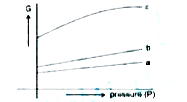Which of the following representation is not correct for the change below? (Consider all substances at 0k are perfect crystals)
pA+qBΔrS91−−−→rC=sD(298K)↓ΔrS4ΔrS3−−−→↑ΔrS2pA+qB(0K)rC=sD(0K)Solution in Telugu
Δrs01=(rs0C+sS0D)−(ps0A+qs0B)
Δrs3=0
Δrs2=−(rs0C+ss0D)
Δrs4=+(ps0A+qs0B)
The correct Answer is:C, D
Step by step video, text & image solution for Which of the following representation is not correct for the change below? (Consider all substances at 0k are perfect crystals) {:(pA + qB,overset(Delta_(r )S_(1)^(9))rarr,underset((298K))(rC= sD)),(darr Delta_(r )S_(4),overset(Delta_(r )S_(3))rarr,uarr Delta_(r)S_(2)),(underset((0K))(pA + qB),,underset((0K))(rC=sD)):} by Chemistry experts to help you in doubts & scoring excellent marks in Class 12 exams.
Topper's Solved these Questions
- BOOK - AAKASH SERIESCHAPTER - CHEMICAL THERMODYNAMICSEXERCISE - Additional Practice Exercise54videos
CHEMICAL THERMODYNAMICS
- BOOK - AAKASH SERIESCHAPTER - CHEMICAL THERMODYNAMICSEXERCISE - Practice Sheet- Exercise-III30videos
CHEMICAL THERMODYNAMICS
- BOOK - AAKASH SERIESCHAPTER - CHEMICAL KINETICSEXERCISE - Objective Exercise - 4 (Assertion (A) & Reason (R) Type Questions)44videos
CHEMICAL KINETICS
- BOOK - AAKASH SERIESCHAPTER - CHEMISTRY IN EVERY DAY LIFEEXERCISE - PRACTICE EXERCISE29videos
CHEMISTRY IN EVERY DAY LIFE
Similar Questions
Which among the following is not an exact differential?
02:50View SolutionThe following curve represents the variation of Gibbs function 'G' with pressure at constant temperature. Correct match of given plots with the physical state of a substance is
 05:08View Solution
05:08View Solution(A) Spontaneous reaction may be slow or fast.
(R ) Spontaneous nature deals with feasibility of the reaction but not rate.View SolutionAnti allergy drugs are
View SolutionThe approx value of K for a reaction AhArrB is : Given Delta_(r)H_(298K)^(@)=-54.07KJmol^(-1) , Delta_(r)S_(298K)^(@)=10Jk^(-1)mol^(-1) and R=8.314JK^(-1)mol^(-1) .
View SolutionCalculate Delta_(r)G^(@) for (NH_(4)Cl,s) at 310K. Given : Delta_(r)H^(@)(NH_(4)Cl,s) =-314 kj/mol, Delta_(r)C_(p)=0 S_(N_(2)(g))^(@)=192 JK^(-1mol^(-1)),S_(H_(2)(g))^(@)=130.5JK^(-1)mol^(-1), S_(Cl_(2)(g))^(@)=233JK mol^(-1), S_(NH_(4)Cl(s))^(@)=99.5JK^(-1)mol^(-1) All given data at 300K
View SolutionStandard Gibbs energy of reaction (Delta_(r)G^(@)) at a certain temperature can be completed as Delta_(r)G^(@)=Delta_(r)H^(@)-Tdelta_(r)S^(@) and the change in the value of Delta_(r)H^(@) and Delta_(r)S^(@) for a reaction with temperature can be computed as follows: Delta _(r) H_(T_(2))^(@)-Delta_(r)C_(p)^(@)(T_(2)-T_(1)) Delta_(r)S_(T_(2))^(@)-Delta_(r)S_(T_(1))^(@)=Delta_(r)C_(p)^(@)In ((T_(2))/(T_(2))) Delta_(r)G^(@)=Delta_(r)H^(@)-T.Delta_(r)S^(@) Delta_(r)^(@)G^(@)=-RTInK_(eq) Consider the following reaction : CO(g)+2H_(2)(g)toCH_(3)OH(g) Given Delta_(r)H^(@)(CH_(3)Oh,g]=-201KJ//mol Delta_(r)H^(@)(CO,g)=-114KJ//mol s^(@)(CH_(3)OH,g)=240J//mol-k, S^(@)(H_(2)g)=198J//mol-K C_(p.m)^(@)(h_(2))=28.8JK^(-1)mol^(-1) C_(p.m(CO)=29.4J//mol-K C_(p.m)^(@)(CH_(3_)OH)=44J//mol-K and In ((320)/(300))=0.06,"all data at"300K. Delta_(r)S^(@) at 300 K for the reaction is :
02:22View SolutionStandard Gibbs energy of reaction (ΔrG∘) at a certain temperature can be completed as ΔrG∘=ΔrH∘−TδrS∘ and the change in the value of ΔrH∘ and ΔrS∘ for a reaction with temperature can be computed as follows:
ΔrH∘T2−ΔrC∘p(T2−T1)
ΔrS∘T2−ΔrS∘T1=ΔrC∘pIn(T2T2)
ΔrG∘=ΔrH∘−T.ΔrS∘
Δ∘rG∘=−RTInKeq
Consider the following reaction :
CO(g)+2H2(g)→CH3OH(g)
Given
ΔrH∘(CH3Oh,g]=−201KJ/mol
ΔrH∘(CO,g)=−114KJ/mol
s∘(CH3OH,g)=240J/mol−k,
S∘(H2g)=198J/mol−K
C∘p.m(h2)=28.8JK−1mol−1
Cp.m(CO)=29.4J/mol−K
C∘p.m(CH3□OH)=44J/mol−K
andIn(320300)=0.06,all data at300K.
ΔrH∘at 300K for the reaction is :03:54View SolutionStandard Gibbs energy of reaction (ΔrG∘) at a certain temperature can be completed as ΔrG∘=ΔrH∘−TδrS∘ and the change in the value of ΔrH∘ and ΔrS∘ for a reaction with temperature can be computed as follows:
ΔrH∘T2−ΔrC∘p(T2−T1)
ΔrS∘T2−ΔrS∘T1=ΔrC∘pIn(T2T2)
ΔrG∘=ΔrH∘−T.ΔrS∘
Δ∘rG∘=−RTInKeq
Consider the following reaction :
CO(g)+2H2(g)→CH3OH(g)
Given
ΔrH∘(CH3Oh,g]=−201KJ/mol
ΔrH∘(CO,g)=−114KJ/mol
s∘(CH3OH,g)=240J/mol−k,
S∘(H2g)=198J/mol−K
C∘p.m(h2)=28.8JK−1mol−1
Cp.m(CO)=29.4J/mol−K
C∘p.m(CH3□OH)=44J/mol−K
andIn(320300)=0.06,all data at300K.
Δrs∘ at 320K is:02:37View SolutionStandard Gibbs energy of reaction (Delta_(r)G^(@)) at a certain temperature can be completed as Delta_(r)G^(@)=Delta_(r)H^(@)-Tdelta_(r)S^(@) and the change in the value of Delta_(r)H^(@) and Delta_(r)S^(@) for a reaction with temperature can be computed as follows: Delta _(r) H_(T_(2))^(@)-Delta_(r)C_(p)^(@)(T_(2)-T_(1)) Delta_(r)S_(T_(2))^(@)-Delta_(r)S_(T_(1))^(@)=Delta_(r)C_(p)^(@)In ((T_(2))/(T_(2))) Delta_(r)G^(@)=Delta_(r)H^(@)-T.Delta_(r)S^(@) Delta_(r)^(@)G^(@)=-RTInK_(eq) Consider the following reaction : CO(g)+2H_(2)(g)toCH_(3)OH(g) Given Delta_(r)H^(@)(CH_(3)Oh,g]=-201KJ//mol Delta_(r)H^(@)(CO,g)=-114KJ//mol s^(@)(CH_(3)OH,g)=240J//mol-k, S^(@)(H_(2)g)=198J//mol-K C_(p.m)^(@)(h_(2))=28.8JK^(-1)mol^(-1) C_(p.m(CO)=29.4J//mol-K C_(p.m)^(@)(CH_(3_)OH)=44J//mol-K and In ((320)/(300))=0.06,"all data at"300K. Delta_(r)H^(@) at 320K is :
03:24View SolutionWhich of the following is correct for the change shown below ? underset(298K)(aA+bB) overset(Delta_(r)S_(1)^(@))rarrcunderset(298)(C+dD) Delta_(r)S_(1)^(@)darr " " uarr Delta_(r)S_(4)^(@) underset(0K)(aA+bB) overset(Delta S_(3)^(@))rarr cunderset(0K)(C+dD)
02:27View SolutionIn the following S_(N)1 reaction: underset(S_(N)1)overset(OH^(o+))rarr(A) is
07:11View SolutionCalculate Delta_(r)S_("sys")^(@) for the following reaction at 373 K: CO(g) + H_(2)O(g) to CO_(2)(g) + H_(2)(g) Delta_(r)H^(@) = -4.1 xx 10^(4) J, Delta_(r)S^(@)("unv") = 56 J//K
07:11View SolutionIf Sn=n∑r=01nCr and Tn=n∑r=0rnCr then tnsn =
01:57View SolutionCalculate ΔrG∘ for (NH4Cl,s) at 310K.
Given :ΔrH∘(NH4Cl,s) =-314 kj/mol,ΔrCp=0
S∘N2(g)=192JK−1mol−1,S∘H2(g)=130.5JK−1mol−1,
S∘Cl2(g)=233JKmol−1,S∘NH4Cl(s)=99.5JK−1mol−1
All given data at 300K04:02View Solution

